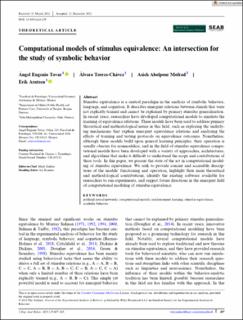Computational models of stimulus equivalence: An intersection for the study of symbolic behavior
Journal article, Peer reviewed
Published version

Åpne
Permanent lenke
https://hdl.handle.net/11250/3115088Utgivelsesdato
2023Metadata
Vis full innførselSamlinger
Originalversjon
Journal of The Experimental Analysis of Behavior. 2023, 119 (2), 407-425. 10.1002/jeab.829Sammendrag
Stimulus equivalence is a central paradigm in the analysis of symbolic behavior, language, and cognition. It describes emergent relations between stimuli that were not explicitly trained and cannot be explained by primary stimulus generalization. In recent years, researchers have developed computational models to simulate the learning of equivalence relations. These models have been used to address primary theoretical and methodological issues in this field, such as exploring the underlying mechanisms that explain emergent equivalence relations and analyzing the effects of training and testing protocols on equivalence outcomes. Nonetheless, although these models build upon general learning principles, their operation is usually obscure for nonmodelers, and in the field of stimulus equivalence computational models have been developed with a variety of approaches, architectures, and algorithms that make it difficult to understand the scope and contributions of these tools. In this paper, we present the state of the art in computational modeling of stimulus equivalence. We seek to provide concise and accessible descriptions of the models' functioning and operation, highlight their main theoretical and methodological contributions, identify the existing software available for researchers to run experiments, and suggest future directions in the emergent field of computational modeling of stimulus equivalence.
